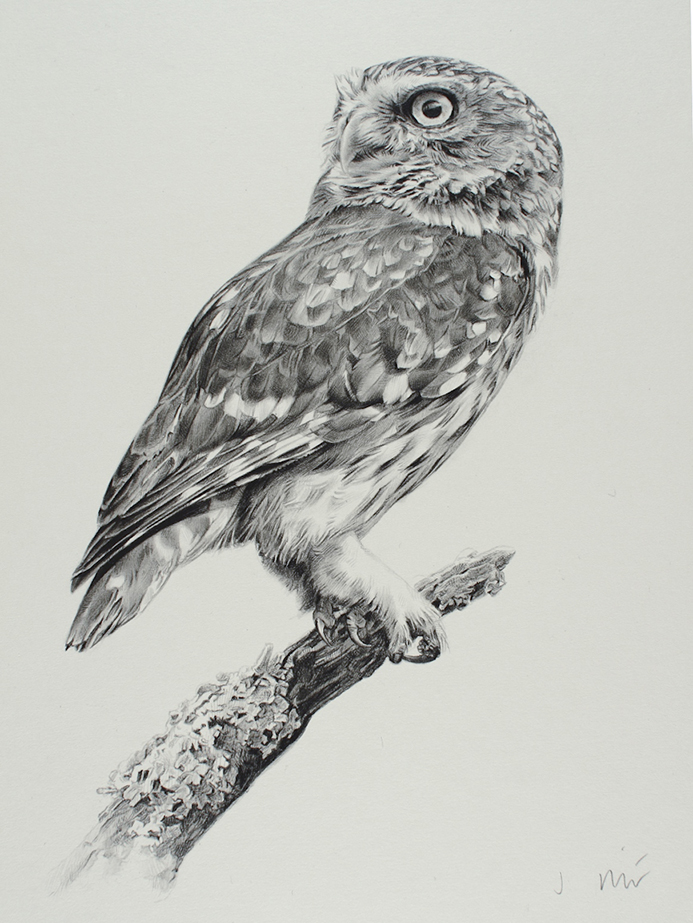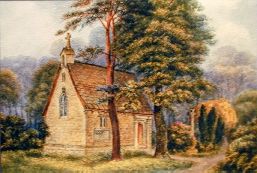The Little Owl is the smallest of the British Strigiformes. It is a plump bird, about the length of a mistle thrush, with a flat head and pronounced whiteish eyebrows which can give it a stern, censorious appearance.
It inhabits all but the colder parts of Europe and Asia as far east as the Korean peninsula. It is also present in parts of North Africa and Arabia. As if to emphasise its adaptability, the Little Owl has also been established in New Zealand. Nor is is it native to Britain. It was first introduced in 1842 by Thomas Powys and in the succeeding decades further introductions were made. Since the turn of the nineteenth century it has become a successful breeding bird in all counties of England and Wales and is now breeding in the Scottish Lowlands also.
As a "no status" bird, conservation groups take a rather stuffy view. The British Trust for Ornithology (BTO) has asserted that "as a non-native species we do not consider it to be of conservation value". Mark Avery, formerly conservation officer of the RSPB has said that he "probably wouldn't be very keen on an introduction like this nowadays" before admitting "I don't know of any harm done to our native fauna by the Little Owl". It is truly native, of course, just 20 miles away across the Channel!
Nesting takes place from about mid April to June often in pollarded trees or in derelict buildings though crevices or even rabbit burrows may also be used. Typically 3-5 eggs are laid with incubation lasting about four weeks; at about 35 days old the young fledge.
Territories frequently remain occupied throughout the year.
Beetles, grasshoppers and earthworms form the dietary staple but lizards, frogs and small birds are taken when the opportunity presents.
According to Greek Mythology, Athene, Goddess of Wisdom, was so impressed by the sagacity of the Little Owl that she conferred upon it the honour of noblest of all birds. Its watchfulness, implacability and wraith-like ability to arrive unobserved was without equal. The Little Owl's taxonomic name, Athene noctua, recalls the unique distinction which the Olympian goddess of war, commerce, wise counsel and heroic endeavour deemed befitting this small owl.
Athenian tetradrachm of 5th century B.C.
Athenian tetradrachm of 2nd century B.C.
The Little Owl possessed a supernatural "inner light" which gave it not only an ability to see in the dark but also the power of prescience: the ability to see into the future. It was, and still is, a familiar sight around Greek classical temples and this served to strengthen the perception of the Little Owl in the everyday lives of the Ancients both as guardian and as foreteller of danger.
Equally in the commerce of peacetime as in the perils of war the Little Owl was a potent omen. If Athenian soldiers sighted it on the eve of battle they were emboldened in the knowledge that they could not be defeated.
Oddly it seems that the converse was true if one were to dream of the Little Owl. The second century Roman soothsayer Artemidorus warned that this foretold a shipwreck: sailors would desperately seek an anchorage and traders would see this inauspicious sign as reason to put off their bargaining for another day.
Like Athene before her Minerva, the Roman Goddess of Wisdom, was similarly to adopt the Little Owl as her chosen companion. The Athenian owl legends would gain new currency this time with Minervan provenance.
These legends are recalled in the present day name for the Little Owl in Sweden: Minervauggla; in Finland it is known as Minervanpollo.
Just as for the Greeks, the Little Owl, gifted with the power of divination, was the most ominous of birds: its appearance foretold the deaths of Caesars Augustus, Commodus Aurelius and Agrippa. Most famously perhaps, as Shakespeare reminds us, it also announced the imminent death of Julius Caesar:
"...yesterday, the bird of night did sit Even at noonday, upon the market place, Hooting and shrieking".
In Roman mythology Proserpine (Persephone) was consigned to the underworld where Ascalpus reported her as eating the forbidden fruit of a pomegranate. He expected to be rewarded for this piece of intelligence but was instead turned into an owl, a "loathsome bird".
In contrast to Greek beliefs, a Roman army would regard the sight of an owl before battle as a harbinger of disaster. At Carrhae on the ancient plains of Mesopotamia the appearance of the Little Owl presaged a most inglorious day. Here in 53 B.C. the army of the Parthian Empire inflicted an humiliating defeat upon the invading force of Romans, who, though superior in numbers, were put to rout by the Parthian cavalry. The Roman commander Crassus was killed and the surviving members of his army were enslaved.
This was to endure as one of Rome's most crushing defeats.
This was to endure as one of Rome's most crushing defeats.
Modern science has demystified much of the lore surrounding the Little Owl and indeed owls in general but to hear its call at night or to meet its gaze still, in me at least, invokes a sort of primal response.
One English superstition had it that in order to negate the baleful effect of an owl observing you, you should walk around and around the tree in which he sat in order that he may wring his own neck.
One English superstition had it that in order to negate the baleful effect of an owl observing you, you should walk around and around the tree in which he sat in order that he may wring his own neck.
In Britain, as recently as the eighteenth century, owls would be nailed to barn doors to protect livestock from curse, lightning strike or similar misadventure.
Birds of omen dark and foul,
Night-crow, raven, bat, and owl,
Leave the sick man to his dream --All night long he heard your scream.
Night-crow, raven, bat, and owl,
Leave the sick man to his dream --All night long he heard your scream.
-Sir Walter Scott
In many societies owls are still associated with death and even in the West the notion of the "wise old owl" retains its currency.
Although severely affected by bad winters the Little Owl is a species of "least concern".
Photographs (all taken in Sefton) remain copyright of C McIndoe.
Link:















.jpg)

